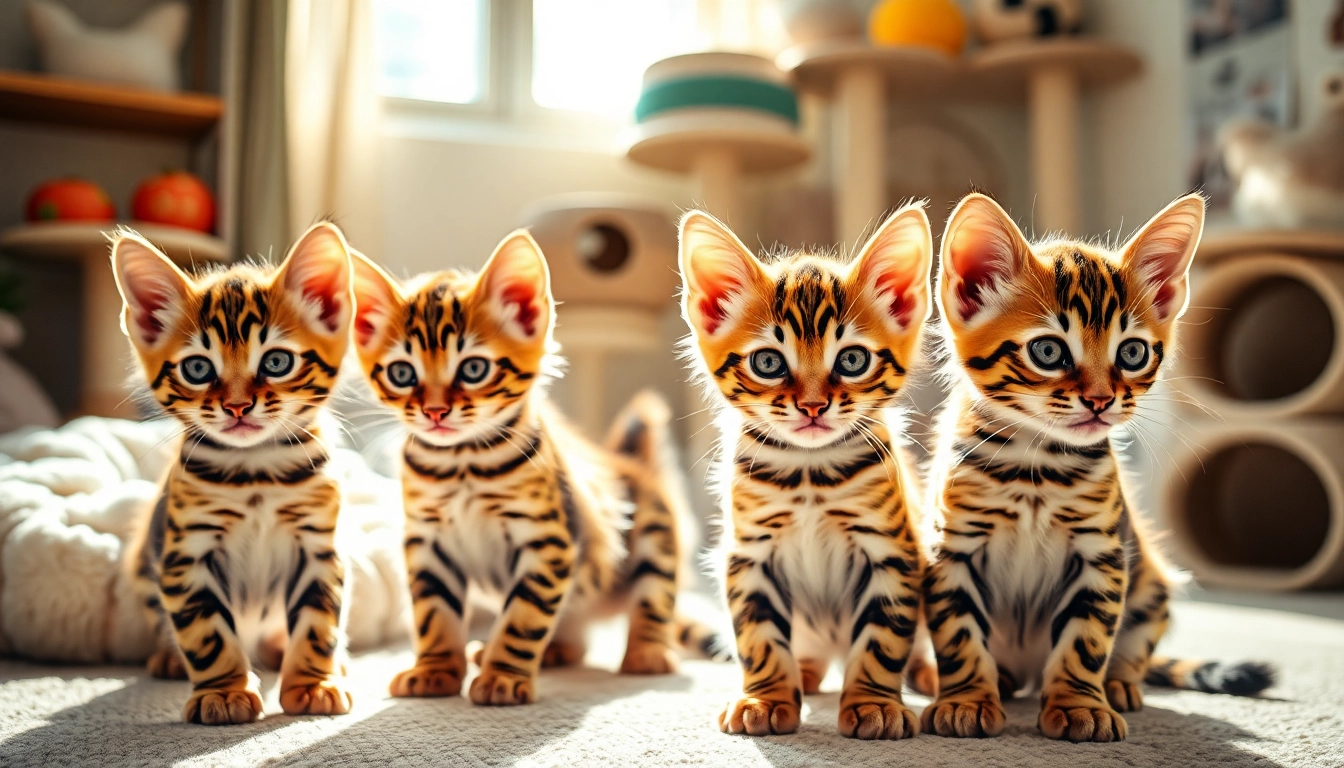Understanding the Bengal Breed
Origin and History of Bengal Kittens
The Bengal cat breed that we admire today has a fascinating history rooted in the blending of wild and domestic felines. The Bengal’s ancestry can be traced back to the 1960s when Jean S. Mill, a geneticist, and cat breeder set out to create a breed that possessed the exotic appearance of the Asian leopard cat (Prionailurus bengalensis) but retained the gentle nature of a domestic cat. Mill’s efforts involved crossing a domestic cat with an Asian leopard cat, resulting in a hybrid that displayed striking coat patterns and unique physical attributes.
This breeding program was crucial not only in developing the Bengal coat’s distinctive snow, marble, spotted, and rosetted patterns, but it also aimed to ensure the temperament would be suitable for family living. By the 1980s, the Bengal cat gained recognition as a new breed and was accepted for registration by major cat associations worldwide. Today, Bengal Kittens for Sale can be found across various catteries, showcasing the breed’s captivating beauty and playful personality.
Distinctive Features of Bengal Cats
What sets Bengal cats apart? Their appearance is undoubtedly one of the most eye-catching attributes. Bengals are known for their majestic, muscular build and strikingly beautiful fur, often resembling a small leopard. Their coats feature intricate patterns, including spots and marbling, which can come in various colors such as brown, silver, and snow.
In addition to their vivid coats, Bengal cats have a unique physicality characterized by a long, sleek body, prominent whisker pads, and large, almond-shaped eyes that emphasize their wild ancestry. Their thick tails and large ears are also distinguishing features that add to their appeal. This combination of aesthetic qualities not only makes Bengal cats visually appealing but also contributes to their reputation as one of the most exciting domestic felines around.
Temperament and Behavior Traits
Bengal cats are renowned for their energetic and playful nature. Unlike many cats, they are highly social and enjoy interacting with their human companions as well as other pets. This social disposition requires that potential owners understand the importance of engaging with their Bengals frequently to meet their active lifestyle.
Their intelligence is another hallmark of the breed. Bengals are quick learners and excel in interactive play, which often includes games that stimulate their hunting instincts. As such, prospective owners should plan on investing both time and resources in toys that challenge their kitten mentally and physically.
While Bengal kittens can be affectionate and cuddly, they also have a mischievous streak. They love to climb, explore, and occasionally get into trouble. Owners might find it especially advisable to provide an environment rich in vertical spaces, such as cat trees or shelves, to cater to their climbing skills and keep them entertained.
Finding Bengal Kittens for Sale
Researching Reputable Breeders
When embarking on the quest to find Bengal kittens for sale, it becomes paramount to conduct thorough research to ensure you’re sourcing from reputable breeders. Reliable breeders adhere to ethical breeding practices, prioritize the health and well-being of their cats, and offer transparency regarding the breeding conditions. Start by visiting local catteries and asking potential breeders a series of essential questions, such as health testing protocols and the socialization of kittens.
Additionally, consider joining Bengal breed-specific forums or groups on social media platforms. These communities often provide recommendations for trusted breeders based on firsthand experiences. Moreover, reputable breeders will always encourage visits to their cattery where you can evaluate the living conditions and interact with the kittens and their parents.
What to Look for in a Cattery
Identifying key characteristics of a quality cattery can help you feel confident in your purchase. Initially, assess the cleanliness of the environment. A reputable cattery should maintain high hygiene standards and provide adequate space for each cat to thrive. Kittens should be raised in a nurturing environment, receiving ample socialization from an early age to ensure they display healthy behaviors as they grow.
Furthermore, health and well-being should be the primary focus. Ethical breeders will have health screenings for genetic diseases, and they should be willing to share veterinary records, including vaccinations and deworming treatments. It is also beneficial to inquire about a breeder’s return policy or guarantee should health issues arise after adoption.
Understanding Adoption Fees and Costs
Owning a Bengal kitten can be an investment. Adoption fees can range significantly depending on various factors, including lineage, breeder reputation, and location. Generally, prices for Bengal kittens can start around $1,000 and can reach $3,000 or more for high-quality lineage. Prospective buyers should consider these fees as the initial cost of ownership, along with ongoing expenses like food, veterinary care, and pet insurance.
It’s also advisable to budget for accessories like litter boxes, scratching posts, toys, and potential training tools, which can all contribute to a happy and healthy cat. Understanding these costs upfront will better prepare you for the financial commitment of owning a Bengal.
Preparing Your Home for a Bengal Kitten
Essential Supplies and Equipment
Before bringing a Bengal kitten into your home, it’s crucial to gather all the necessary supplies to ensure a smooth transition. Essentials include a high-quality litter box, litter, food and water dishes, a scratching post, and a cozy bed. Additionally, purchase nutritious kitten food that meets their developmental needs.
Interactive toys are another important addition to any Bengal household. They thrive on stimulation and playtime, making engaging toys vital for their physical and mental development. Consider puzzle toys or feather wands which can help encourage both activity and bonding time between you and your kitten.
Creating a Safe and Stimulating Environment
Creating a safe space for your new Bengal kitten means brushing up on basic home safety modifications. It’s crucial to cat-proof your home by ensuring that hazardous items, such as plants toxic to cats, electrical cords, and small objects, are out of reach. Bengals are agile and curious, so providing high vertical spaces like cat trees or shelves will keep them entertained and enriched while also preventing accidents.
In addition, setting up a quiet, dedicated space where your kitten can retreat and feel secure, especially during the initial adjustment phase, is important. This space should be warm, comfortable, and free from loud noises or disruptions to facilitate a positive arrival experience.
Health Care and Nutrition Basics
Proper health care is vital for your kitten’s well-being. In addition to regular check-ups, vaccinations, and preventative care, developing a nutritious eating regimen is equally significant. High-quality kitten food that is rich in protein and fat is essential to support their growth and energy levels.
Consult with your veterinarian for recommendations on the best diet for your Bengal, as their dietary needs can differ based on factors like age and activity level. Regularly measuring food portions and providing fresh water is key to keeping them healthy and avoiding obesity.
Raising a Happy and Healthy Bengal Kitten
Socialization Tips for Young Kittens
Socialization is critical during a Bengal kitten’s early development. Exposing them to various experiences, sounds, and people during their first few months can significantly influence their social behaviors in adulthood. Allowing your kitten gentle interactions with friends, family, and other pets can help create a well-rounded feline companion who is comfortable in various situations.
In addition to human interactions, providing settings that expose your kitten to different sounds, textures, and toys will stimulate their environment and encourage adaptive behaviors. Implementing varied learning experiences can prevent behavioral issues later on, as a well-socialized Bengal tends to display more confidence and less anxiety.
Training and Housebreaking Strategies
Unlike some cat breeds, Bengal kittens can be surprisingly easy to train, thanks to their intelligence and eagerness to please. Establishing a routine will help with housebreaking and ensure kittens understand which areas are reserved for elimination. Ensure they are introduced to the litter box immediately upon arrival and reward them for using it correctly to reinforce good habits.
In addition to litter training, basic commands and tricks can be taught using positive reinforcement methods. Bengals are smart and patriotic learners, so using treats and praise can greatly enhance understanding and obedience during training sessions.
Common Health Issues to Watch For
While Bengal cats are notably healthy, like all breeds, they are predisposed to certain health issues. Common concerns may include hypertrophic cardiomyopathy (HCM), hip dysplasia, and certain skin conditions. Regular visits to the veterinarian and being aware of any genetic predispositions can help mitigate these health risks.
Additionally, maintaining a healthy weight through proper nutrition and exercise, along with being alert to unusual behaviors, will ensure you can catch potential health issues early. Creating a relationship with a trusted veterinarian who understands the breed is essential for the longevity and vitality of your Bengal cat.
The Joy of Living with Bengal Cats
Understanding Their Unique Personalities
Bengal cats are not just pets; they become cherished family members who bring vibrancy and joy into your home. Their extroverted personalities, combined with playful antics, create a lively atmosphere that many owners swiftly fall in love with. Each Bengal possesses its unique character that may manifest in quirky behaviors, ranging from being vocal to engaging in playful mischief.
Understanding your Bengal’s unique personality traits can forge deeper connections. Regularly engaging with them and observing their preferences in play, rest, and interaction will enhance your relationship, allowing you to meet their emotional needs effectively.
Activities and Playtime with Your Bengal
To keep a Bengal kitten happy, regular playtime is essential. Interactive games that mimic hunting behavior, such as feather wands or laser pointers, can stimulate both their mind and body. Bengals, being naturally active, thrive in environments where they can run, jump, and climb, so providing ample opportunities for exercise is necessary.
Consider integrating regular play schedules that include short bursts of activity coupled with mental challenges, such as puzzle feeders. These activities not only offer physical benefits but also help prevent boredom, which can lead to destructive behavior.
Building a Lasting Bond with Your Pet
The bond between a Bengal and its owner is unique, marked by mutual respect and affection. Spending dedicated quality time with your Bengal through play, grooming, and daily companionship strengthens this bond. Regularly offering praise and positive reinforcement during training helps develop trust and enhances the relationship over time.
Finally, understanding and responding to your Bengal’s body language is vital to nurturing the relationship. Recognizing their likes and dislikes provides insights into their behavior and comfort, ensuring that you can cater to their emotional needs and solidify the bond for years to come.



